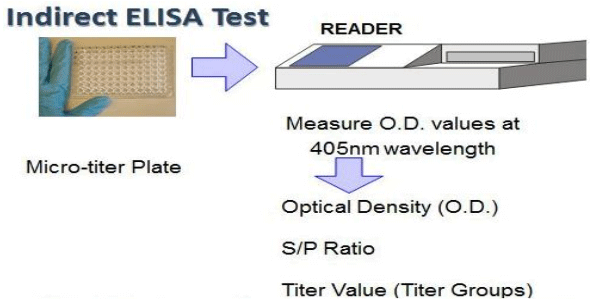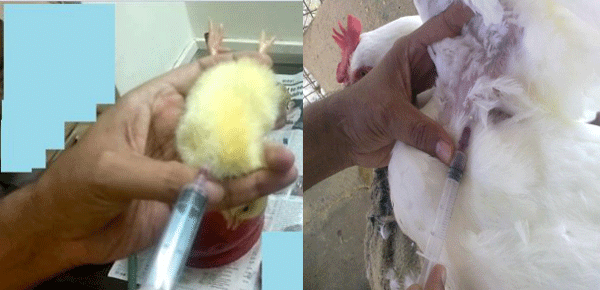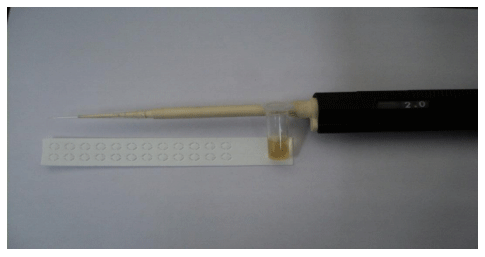Disease Prevention Using Elisa Technique
Published: May 27, 2015
By: Dr.Prasad P Kulkarni (Polchem)
Even vulnerability of market conditions cannot stop the growth of Indian Poultry Industry today. Continuous improvement in genetic potential targeted towards getting better performance from the bird has made this unbelievable success realistic today. Along with the genetic upgradetation, the success can also be credited to nutritional awareness amongst the producers. It however fails to address the crucial issue of conferring adequate immunity to the bird against a battery of bacterial, viral pathogens. Infection pressure in any poultry cluster builds up continuously despite of effective biosecurity measures and innovative vaccination regimes. Modern poultry industry is persistently under threat of several clinical and sub-clinical infection, vaccination failure and combination of infection. Currently, encountered outbreak situations amongst poultry often found to be of multiple infection cases. Such outbreaks essentially require differential diagnosis. The microbiological, pathological and immunological support becomes indispensible during mixed infections.
Even if apparently disease scenario looks complicated in today’s condition, strategic implementation of simple guidelines if followed can help to overcome this situation if followed meticulously. Following three steps guideline may be followed to tackle complex situation of multiple infection.
a) Correct diagnosis/confirmation of disease
b) Mapping immune status of bird
c) Surveillance of disease causing agent in respective area &its prevention
The infective agents vary from area to area and create the difficulty by the way of showing subclinical or hidden presence. Clear idea of clinical and subclinical infections at the site of operations is essential while attempting to re-organise the immunizationof the birds to control the infections. Otherwise lingering infections can take away the profits of this business which itself becoming thin day to day. What we must achieve is the bird competent bird to sustain growth pressure by nullifying disease stress through proper disease control programme by technique of “immunoprofiling” the poultry flocks regularly. The easiest way to do achieve this is by planning protective schedule based on results of flock screening. Reading disease challenge correctly especially sub-clinical manifestations by proper screening of birds periodically we can identify the pathogens and plan the preventive schedule. The technique should map the prevailing pathogenic load in an area with relative immune status of birds which gives line of action for better disease resistance and to achieve optimum performance.This is also called seraprofiling, disease profiling or monitoringof the flock. Immunoprofiling of the flocks can be helpful for:
- Diagnosing vertically transmitted diseases
- Designing protection/vaccination schedule.
- Detecting sub-clinical infections, immunosuppression.
- Measuring vaccine efficacy.
- Reading maternal antibody status to plan vaccination.
In early days tis monitoring of infection to the birds was done using the antigen on plate agglutination like tests to identify the infected stock. Nowadays, on larger size of flock’s dose not only makes it difficult but impossible to test for each disease. Further after invention of sampling techniques tests like Heamagglutination and heanaggulitation inhibition were found reliable for confirmation of diseases like Newcastle and Infectious Bronchitis. But since every virus doesn’t have this property this test was for limited for only few diseases and was not reliable to judge the vaccine response.The traditionally followed HA/HI as good role in disease confirmation were found low precision because of dependency on technician especially for result reading. It also was lacking in precision control on laboratory protocol which is even prevailing even today. Still it was widely used looking at cost convenience. This limitation of other tests to screen bird at the same time for all the diseases together actually developed the wet lab technique called Elisa. Even if the development was gradual, the reproducibility of results compare to old techniques was improved using ELISA. Even lack of standard guidelines was overwhelmed by some of the efficient Elisa plate producers after years of efforts together developing “Baseline” for judging vaccine response, disease confirmation and to plan the immunization. At the same time, when few novel and high precision methods like polymerase chain reaction (PCR) also available were demanding heavy investment, technology and skilled manpower and becoming difficult to establish for common farmers. Considering these two extremes ELISA can be thought as golden mean due to the moderate cost and accuracy.
ELISA been considered as the best amongst presently available diagnostic tool andcan easily understood one by one as classified further:
- Development of Elisa
- Advantages of Elisa
- Sampling technique for Elisa
- Lab processing of samples for Elisa
- Interpretation from the Elisa report
1) Development of Elisa
This novel technique is well accepted worldwide today, but had to overcame many hurdles in with help of technology development. The Initial limitations thought course of technology advancements and modern manufacturing techniques were successfully overcame in and today worldwide it is admired not only for disease confirmation but for planning the preventive schedule too.This process of developenent can be summarise in three major achievements
a) This wet lab technique of Elisa overcame Poor Assay Specificitywhich was biggest challenge in earlier days. Because of purity of antigen was difficult in olden days and culture of antigen was on solid phase this issue made coating of antigen difficult uniformly. With modern techniques of high precision in filtration and cultivation of antigen is not only pure but more reliable and uniform. The antigen is cultured today and coated on surface very successful mainly due to art of manufacturing process which is absolutely without any human interference entirely machine operated uniform. The advancement in infrastructure for storage and transport facilities also helped today Elisa to become more user friendly.
b) The ambiguity in the Elisa in early days showing Low Assay Sensitivity was mainly related to complexity of reagents, its stability, and storage as well as transport facilities. In technology driven era today it has become achievable task. The subsequent development took long time for better alternatives to make reagents easily differentiable, stable and long life since involved lot of research and development. The universal and user friendly protocol was been established thereafter. Today all reagents like Conjugate, Substrate and stop solution were made on ready to use base. This largely contributes to widespread of this technique worldwide.The reagents alkaline phosphatase in conjugate instead of horse radish peroxidase improved the sensitivity of conjugate to large extent. p-Nitrophenyl Phosphate(PNPP) in substrate improves more linear reactionthan tetra methylene blue which four improves accuracy of substrate to large extent. The provision of preparing ready to use substrate in lab immediately the colour development of this procedure more perfectly correlating to the antigen antibody reaction so as to reach correct optical densities and to give perfect sera picture of the bird. Even the wash buffer development was so miraculous which assures removal of the non- specific proteins attached to antigen while washing the plate during the protocol. The reagents “Reference Control “which itself defines validity of procedure and is an extraordinary result of human analogy application. All ready to use solutions with moderately trained person make this technique easy to perform and well acceptable at technician level.
c) Analytical Help - The report interpretation of ELISA still an art. But the baseline data availability with standard manufacturers today makes the Elisa immediately acceptable for good clinicians. The software today can help to generate the own baseline fromsite to site if needful. The parameters like vaccination Index makes analysis of results more clear and diagnosis more perfect in order to provide the guidelines for further action.
These updates makes Elisa the most handy tool which gives perfect guidelines for disease prevention and diagnosis help to the poultry producer in short span.
2) Advantages of Elisa
In a very short span of time this wet lab technique became acceptable on technician and analytical level. The main advantages behind the acceptance were:
- Moderate setup cost.
- Easy for operating.
- Good precision & reliability and reproducibility.
- Highly sensitive and dependable.
- Baseline Guidelines and Vaccination Index parameter which can differentiate vaccinal and infective titres.
- Software help for data keeping and analysis in required format to compare to correlate with flock performance.
3) Sampling Technique for Elisa
In Elisa blood, serum or sometimes from egg yolk extract is used as sample for screening presence of antigen in the bird. The whole process scales the “Antibody” called protein in blood/serum of the bird. The infective agent (virus/Bacteria) when enters the body system responds immunologically producing antibody called proteins by the bird. This degree of response is depends on situation like vaccination, infection or take reaction. This response is quantified using blood or sera as samples form the bird. This wet lab procedure is termed “ELISA”. Elisa is a quantitative test which measures antibodies in serum using optical density reader because of which the accuracy of results is improved to very reliable level avoiding the errors at technician level from all possible angles. The software helps to convert these optical density readings using sample to positive ration to give the “titre” status present in the bird. Enzyme Linked Immuno Sorbent Assay is within three hours discloses the “seropicture”of the flock which can be easily correlated with flock condition accordingly. Baseline provided by kit manufacturers help in deciding the further course of action depending on type of bird age and immunization done before collecting the sample. The technique requires Antigen coated surface plates, reagents like serum diluent, conjugate, substrate, the stop solution along with wash buffer. For example at said age group if antibody levels are lower you can prefer the booster for vaccination. The consulting veterinarian can be a best guide for further course of action. The common guidelines cannot be drawn as the place, age and immunization programme varies in most of the cases. But the technique is becoming so reliable that with good analytical skills. Application of parameters like “Vaccination Index” can help you differentiating vaccinal and infective titres which is unique of its kind found nowhere in any other diagnostic methods.
Figure 1: Principle of Elisa application

The space sufficient for personal computer is good enough to accommodate the whole assembly for Elisa in the lab. The technique comes with defined protocol so makes technician adoptable in short time. Today not only this but the test come with tools like “Reference control” which certifies the validity of test making it most reliable helping to eliminate procedural errors while interpreting the report. The entire process of sampling and its operative part can be summarised in two segments
a) Sampling procedure&
b) Sample transport
a) Sampling Procedure
As the test is carried out on blood/serum of the bird the first important operation is clean serum collection. To carry out Elisa normally blood collection is done by Wing Vein or by direct heart collection (at chick stage) method in poultry.
Figure 2: selection of random samples for blood collection of birds in a poultry shed

Plan the random sampling from shed covering all the areas in shed as shown in the diagram. Tis can be followed in cage or even deep litter rearing. Birds from all part of shed for sampling must be selected. Approximately 1 to 1.5 ml of blood from each bird is sufficient to carry out Elisa. For the flock size up to 10,000 birds, 20-23 random samples need to be collected for correct representation of entire flock carefully as shown in figure 2. If the flock size is large, then collect more samples accordingly for which the suggestible thumb rule of taking 2% birds can be followed. Each shed is treated as one flock and combine 20-23 samples including male birds in breeder can be ideal to represent the sera-picture of the flock. The total 18 female and 5 male is always better ratio for sampling.The sampling depending on specific need can also be done entirely for flock sometimes. In specific cases like Reo virus infection sampling of ailing birds is also suggested for confirmation. For valuable stocks like grandparents all birds individually are screened for diseases like Avian Leucosis Complex.
Figure 3: Blood collection in Chicks (direct heart) and in adult bird (wing vein)

The important points to be considered during blood collection are
a) Minimum 20 samples from flock are good enough to produce true sera-picture of the flock. Birds in one shed must be treated as one flock.
b) 2 ml sized disposable syringes with 22 gauge needle is ideal for blood collection of birds. More narrow needles may lead to hemolysis due to suction pressure.
c) it is better to change syringe after each collection but if needed can be managed by washing the syringe before next collection assuring syringe wash 2- 3 times with sterile saline after every bird is bled. Use 45 degree of angle while pouring syringe blood to collection tube in gentle manner to avoid hemolysis.
d) Coagulation of RBC’s normally within one hour of time is achieved. Sometimes this time lap increases for clotting if blood collection is done immediately after feeding of the flock which do not has any scientific explanation.
e) When the blood is transferred from syringe to a tube, keep the tube in inclined position of 45 degree angle for better serum separation and faster blood clotting.
f) When the serum is separated, take out only the serum in micro centrifuge tube and no clot or red blood cells should intermix.
g) Pale yellow to yellow colored serum samples can be preserved at 0°C for long time without denaturation of proteins. Never keep clotted blood samples at 0°C or below because it get haemolysed and red haemolysed serum is result after thaughing
Figure 4: Proper coagulated blood sample

b) Sample transport
It must be mandatory for proper serum transport that below mentioned points must be taken care without fail otherwise there are many chances of spoiling the collected samples:
- The properly collected blood samples can only be sent by cold chain. It is always safe to send serum samples only separating blood clots.
- Like live vaccine it has to be packed in insulated thermocol boxes and has to be tightly packed using cooling pads to maintain cooling.
- It should travel in cool temperature range of 4 to 8 degrees. Precaution has to be taken for fast and safe transportation.
In field conditions where cold-chain transport system is difficult for the serum transport filter paper method can be applied which also give accurate results. Separate dilution protocol is also been defined for the same.
Transport on filter paper:
Figure 5: Micropipette and filter paper for easy transport

- Two micro-liter of each serum sample is to be placed on the respective disc cutout of the strip as shown in picture using good precision pipette.
- Tightly attach the tip on the micropipette before placing the serum on filter paper disc please ensure that outside portion of the tip does not have any serum sticking to it.
- Use fresh tip for each sample.
- Repeat the same procedure for all the samples by placing them in a row.
- Let the strip air dry. Write down all the necessary flock details alongside the rows of spots with the help of a lead pencil.
- Place the strip securely in a polythene bag and keep it in an envelope and courier the envelope wherever required.
4) Lab processing of samples for Elisa
It is recommended that the whole Elisa procedure must be done at room temperature in between 22 to 27 degree centigrade. This is to avoid effect of temperature on antigen antibody reaction and also interference of non-specific proteins during the reaction. The technician preferably be a trainedone. Since the plate is antigen coated it must be stored in the temperature range of 4 to 8 degree of in refrigerator carefully. Keep technicians available in a rotation work plan so as to train all team and handle the absence of any one.The kit is with defined protocol along with for the procedural details. A single kit carries antigen coated plates sufficient to test 480 samples that mean 25 flocks. The actual processing of reagents with their application are summarised as below (Lab protocol of Elisa)-
- All the reagents and serum must be room temperature while performing Elisa. The antigen coated plate is used in which the serum is poured for creating antigen antibody adhesion. If the antibodies are present in sample it will adhere to antigen coated on plate. For quantifying the same rest of process is followed
- The incubated plate after antigen antibody reaction and subsequent washing is further processed with conjugate solution which contains the anti-chicken antibodies clubbed together with oxidizing enzyme. This is for the purpose of giving colour tomeasure the degree of reactionquantitatively. Here the antigen antibody complex formed in first step attracts to anti-chicken antibodies in conjugate. The degree of reaction is directly proportional to antibodies present in the serum sample.
- The conjugate processed plate after the incubation and subsequent washing is subjected to substrate. The plate now contains antigenantibody complex attached to anti-chicken antibodies and oxidizing enzyme with it. This then exposes substrate solutionwhich due to oxidation (Enzyme used in earlier step) starts developing colour. This reaction after defined time exposure is controlled using stop solution.
- The degree of colour development which is directly proportional antibodies present in serum is measured against light of defined nanometres wavelength by optical density of reader to avoid the manual error. The software provided reads the optical densities of all the samples.
- The optical readerbased on readings of positive controls, negative controls provided along with sample readings calculates the sample positive ratio(S:P ratio). Based on this S to P ratio it takes the help of software to convert these OD readings to titre values.
- The report can be obtained in desired format using software. It represents the graphical picture in which mean titres from the flock are shown along with individual sample titres and CV. Coefficient of variation represents variation as usual which can be good guideline for differentiating vaccine titres and natural infection of flock.
- Standard companies provide the baseline data which gives range of titres generated after lot of study, number experiments. This is then compared with generated report. This comparison called analysis can give the result whether the flock is exposed to tested pathogen or not. With this even response to vaccination or pathogen can be concluded.
- The reference control serum which is expected to arrive at predefined titre value. This is treated as sample during the kit processing and is reported separately to certify validity of procedure. This is exceptional tool developed by modern and technically expert kit producing companies to point out procedural error.
- The vaccination Index called parameter helps in differentiating vaccine derived and infection responded titres and also gives guidelines on vaccination response. The baseline data generated is presented in results using the user friendly software offers lot of analytical work in readymade form, including automatic interpretation too.
5) Interpretation from Elisa report
It is always suggested to decide purpose of screening the flock by Elisa before you plan it. Sometimes it can be for diagnostic confirmation, sometimes for planning immunization and sometimes for reading the response. It is very skilful job to draw conclusion out of Elisa report even though expert veterinarians can make it easily. It is also important to correlate the current Elisa report with current flock status, vaccination of bird and clinical conditions.
The report mainly gives titre values of flock, birds individually and coefficient of variation along with. Depending on the type of bird, stage and age a good clinician can easily draw conclusion out of it. This simply needs the comparison of report with the defined baseline. It is as good as reading haematology report of a human being comparing with normal standard values. The good and reputed kit producing companies also provide the provision of automatic interpretation in their software.
Conclusion
The growth of poultry seems unstoppable in-spite of all the odds. The inevitable problems with the growth pressure with genetic upgradetation of bird along with expansion of poultry industry mainly contribute spread of disease agents. The complexities of farming are growing along with population due to feed prices, lack of manpower, dense population and mixed farming. In order to Control this issue the perfect monitoring is needed which can give guidelines for disease control plan. Amongst all the available diagnostic techniques ELISA stands as a golden mean for the diagnostic and control guidelines because:
- Moderate cost.
- Easy to operate and reliable methodology.
- Biocheak’s interpretation guidelines for report analysis.
- Quick- the test takes not more than 2 to 3 hrs.
- Same protocol for multiple antigens.
- Computer controlled so more reliable and less possibility of human error for result the company BIOCHEK has developed an advance concept of reference control serum which is a standardized serum with measured antibody concentration. This helps greatly to determine accuracy of Elisa procedure and makes easy to confirm validity of the test.
- Reproducible – It has been proven with number of experiments that it gives good reproducible and accurate results.
- Sensitive- Can detect antigen at very low concentration as early as 10 days after vaccination or challenge.
This technique of ELISA is a prove tool today which provides help in disease confirmation and in guidelines for solving the disease problems anywhere.
Related topics
Authors:
Join to be able to comment.
Once you join Engormix, you will be able to participate in all content and forums.
* Required information
Would you like to discuss another topic? Create a new post to engage with experts in the community.
Create a post13 de octubre de 2015
Dear Mr Lubao
Like u I have bred a variety of birds including game birds for several years, lot of information I can share with you, I was involved in Elisa screening of pureline birds, trained at Shavers Poultry Breeding Farms in Canada, u can contact me on my mail ID: skmaini@yahoo.com
Information about Breeding and their health, disease control and management I can help you, its all free you don't even have to say thanks if it helps you.
6 de octubre de 2015
In the process of looking for new things Poultry is being ruined dr belwal, solve the problems of the farmers, they need solutions not philosophically
6 de octubre de 2015
The original topic is being deviated, local gene pool, fighting cock breading, vaccine program etc are being discussed, this is the main. Problem with Poultry, no two vets will agree on a point, and the future of poulty is in their hands
Indbro Research & Breeding Farms
5 de octubre de 2015
Please post the vaccination program followed.
What are the post mortem findings in dead birds?
If you are finding tumors inspite of proper mareks vaccination you may have to screen your birds for avian leucosis virus. This can be done by elisa testing using alv antibody kits. If you are breeding your own birds this protocol can be essential.
Dr.kotaiah
AL WADI POULTRY FARMS COMPANY
3 de octubre de 2015
I agree with that opinion because we could evaluate the immune stats of the flocks(firstly).then we can predict the time of vaccination(second).we can judge the vaccination procedure.about zero titre.or good titre.....etc.
1 de octubre de 2015
A good commercial articalto promote Elisa equipment, kits and services, baseline titres of one area will be useless in other areas, base line titres will depend upon vaccine program used, the breed, the nutrition, the stress factors and many more factors, you can not solve any Poultry disease problem using Elisa tech alone, if this was true -why there r so many diseases in the Poultry industry, and nothing in the country birds and unvaccinated chicken
13 de octubre de 2015
Bravo I appreciate your proactiveness to help others Mr.Maini and people should explore and exploit same.
Al-Watania Poultry
13 de octubre de 2015
Re Mr Lubao concern, I agree that using diagnostic tool like ELISA for assessing our flocks immunity, preventing thereof through timed vaccination. Im concern with the ROI of establishing a laboratory for a business like fighting cocks which has normally less than a thousand in population. I suggest that you find a veterinary laboratory near your place or even in Manila where you can send your blood samples through a fast courier. These labs are equipped with the latest diagnostic tools like ELISA and the expertise of evaluating titers and your situation. you can ask them or they can refer you to an expert to advise you about your situation, eg. programming your vaccination, diagnosis of causes of mortality.
In Manila you have NADDL (National Animal Diagnostic Laboratory) just as an example.
Adisseo
13 de octubre de 2015
Thanks everyone for going through article and your comments too. My motto is to improve upon the efficiency as a field veterinarian through such communication media. In such case specially non-pro comments are helpful to guide on leftover line of thinking that one may miss to address. Someone mentioned the different line of thinking that every vet has which I feel is a urge of improvement for deciding better line of action as a diagnostician . So let's agree to disagree for issue based discussions taking it in positive spirit. Here let me accept that there are many microbiological tests that help in diagnosis, confirmation and disease control in poultry other than Elisa and are also helpful but to me Elisa is handy tool.
Dear Mr.Lubao,
Sorry for the delayed response.
In phase outbreaks we need to confirm the primary and secondary or sub-clinical infections to decide line of treatment. Looking at your cited details 5% mortality indicates close to desirable management. Here to explain I foresee two main issues one IBD and the other one respiratory as you narrated.
In case of IBD infection, we map maternally derived antibodies by bleeding day old chicks. Depending on these levels, correlating with the half life of MAB we propose the protective plan of immunization with different antigens. The two available vaccines called intermediate and intermediate plus for Gumboro are proposed at 250 and 500 levels of MAB of the population. But this is very tricky exercise as very high heterogenous population(high CV) one may may require 3 vaccines. Depending on variation of MAB's population is divided in groups to plan the proper protection of entire flock. Some times to avoid variation in MAB of chicks flock wise egg setting in hatchery and respective flock placement is suggested.
In your case since it is different line of birds you need to confirm the half life practically by doing Elisa. Bringing the uniformity in MAB level of chicks by proper periodic vaccination to PS and accordingly planning the commercial flock vaccination & placement is very much possible using Elisa offering the control to IBD. I have gone through some literatures of Immune complex vaccine producing companies assuring good control over shedding of infective field virus which may also be helpful in your case. But as it's not available here In India I have not seen it practically. If available there you can try this.
Nevertheless biosecurity specially terminal disinfection must be to the optimum level for IBD control.
Second issue of concern is respiratory and a big topic to cover also needs confirmation of disease before going ahead as every pathogen has different line of control. Seroprofling by Elisa can help confirmation of pathogen. Commonly seen problem is Mycoplasma (many times is at Subclinical level) and once confirmed controlling infection using vaccine or drugs offer fare level of success. At the same time good ND protection and optimum gut health through nutrition is desired.
We also can communicate over email you referred for more details.
Do admire everyone's attention for the topic.
7 de octubre de 2015
Please go through Dr.Kulkarnis literature as it speaks your concerns.I welcome if Dr. Kulkarni could intervene and divulge more details through soft copy to everyones mail.My mail address is rp_chakraborty@rediffmail.com. It seems to be prudent to have replication to all fraternity amd valuable readers.
















.jpg&w=3840&q=75)